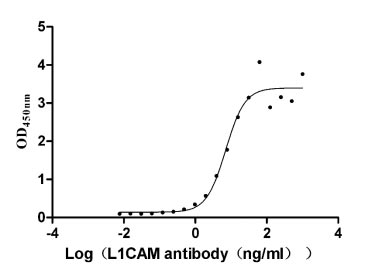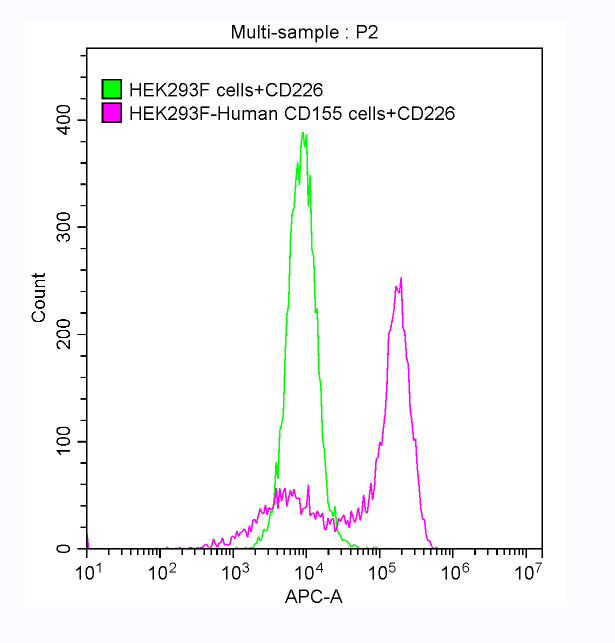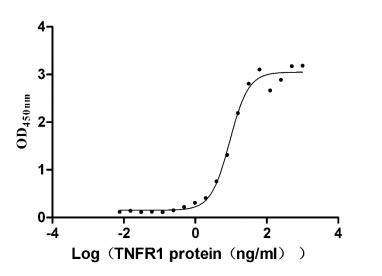Recombinant Mouse Type-2 angiotensin II receptor (Agtr2), partial
-
中文名称:Recombinant Mouse Type-2 angiotensin II receptor(Agtr2),partial,Yeast
-
货号:CSB-YP001466MO
-
规格:
-
来源:Yeast
-
其他:
-
中文名称:Recombinant Mouse Type-2 angiotensin II receptor(Agtr2),partial,Yeast
-
货号:CSB-EP001466MO
-
规格:
-
来源:E.coli
-
其他:
-
中文名称:Recombinant Mouse Type-2 angiotensin II receptor(Agtr2),partial,Yeast
-
货号:CSB-EP001466MO-B
-
规格:
-
来源:E.coli
-
共轭:Avi-tag Biotinylated
E. coli biotin ligase (BirA) is highly specific in covalently attaching biotin to the 15 amino acid AviTag peptide. This recombinant protein was biotinylated in vivo by AviTag-BirA technology, which method is BriA catalyzes amide linkage between the biotin and the specific lysine of the AviTag.
-
其他:
-
中文名称:Recombinant Mouse Type-2 angiotensin II receptor(Agtr2),partial,Yeast
-
货号:CSB-BP001466MO
-
规格:
-
来源:Baculovirus
-
其他:
-
中文名称:Recombinant Mouse Type-2 angiotensin II receptor(Agtr2),partial,Yeast
-
货号:CSB-MP001466MO
-
规格:
-
来源:Mammalian cell
-
其他:
产品详情
-
纯度:>85% (SDS-PAGE)
-
基因名:
-
Uniprot No.:
-
别名:Agtr2Type-2 angiotensin II receptor; Angiotensin II type-2 receptor; AT2
-
种属:Mus musculus (Mouse)
-
蛋白长度:Partial
-
蛋白标签:Tag type will be determined during the manufacturing process.
The tag type will be determined during production process. If you have specified tag type, please tell us and we will develop the specified tag preferentially. -
产品提供形式:Lyophilized powder
Note: We will preferentially ship the format that we have in stock, however, if you have any special requirement for the format, please remark your requirement when placing the order, we will prepare according to your demand. -
复溶:We recommend that this vial be briefly centrifuged prior to opening to bring the contents to the bottom. Please reconstitute protein in deionized sterile water to a concentration of 0.1-1.0 mg/mL.We recommend to add 5-50% of glycerol (final concentration) and aliquot for long-term storage at -20℃/-80℃. Our default final concentration of glycerol is 50%. Customers could use it as reference.
-
储存条件:Store at -20°C/-80°C upon receipt, aliquoting is necessary for mutiple use. Avoid repeated freeze-thaw cycles.
-
保质期:The shelf life is related to many factors, storage state, buffer ingredients, storage temperature and the stability of the protein itself.
Generally, the shelf life of liquid form is 6 months at -20°C/-80°C. The shelf life of lyophilized form is 12 months at -20°C/-80°C. -
货期:Delivery time may differ from different purchasing way or location, please kindly consult your local distributors for specific delivery time.Note: All of our proteins are default shipped with normal blue ice packs, if you request to ship with dry ice, please communicate with us in advance and extra fees will be charged.
-
注意事项:Repeated freezing and thawing is not recommended. Store working aliquots at 4°C for up to one week.
-
Datasheet :Please contact us to get it.
相关产品
靶点详情
-
功能:Receptor for angiotensin II. Cooperates with MTUS1 to inhibit ERK2 activation and cell proliferation.
-
基因功能参考文献:
- Study showed that in type 1 diabetes, angiotensin II type 2 receptor may reduce glycaemia and display anti-oxidant and/or anti-inflammatory properties in association with greater vasodilatation in mesenteric arteries and in the renal vasculature, a major target of diabetes. PMID: 28361992
- the expression of AT2 receptors was significantly increased compared to that of AT1 receptors upon ischemic induction. PMID: 29710550
- study identifies AT2R on peripheral MPhis as a critical trigger for pain sensitization at the site of nerve injury, and therefore proposes a translatable peripheral mechanism underlying chronic neuropathic pain. PMID: 30082378
- Data suggest that the anticoagulant effects of rivaroxaban are promoted by angiotensin II via angiotensin type 2 receptor and Mas signaling. These findings are significant for the clinical administration of rivaroxaban. PMID: 28337024
- crosstalk between AT2 receptor stimulation and PPARgamma activation could contribute to attenuation of vascular intimal proliferation PMID: 26471325
- Deletion of AT2 receptor reduced SHP-1 activity and restored VEGF actions, leading to an increased blood flow reperfusion after ischemia in diabetes mellitus. PMID: 29074590
- Our current results reinforce the notion that the AT2R has a physiological role in the conservation of insulin action PMID: 27979738
- Ultra-high doses did not influence the ACE2/AT2R/Mas axis and promoted renal injury with increased renal ERK1/2 activation and exaggerated fibronectin expression in db/db mice. Our study demonstrates dose-related effects of candesartan in diabetic nephropathy: intermediate-high dose candesartan is renoprotective, whereas ultra-high dose candesartan induces renal damage. PMID: 27612496
- This study aimed to define whether sex chromosome complement (SCC) may differentially modulate sex differences in relative gene expression of basal Agtr1a, Agtr2, and Mas1 receptors at fore/hindbrain nuclei and at medulla/cortical kidney. PMID: 28254489
- loss of AT2 R is associated with podocyte loss/dysfunction and is mediated, at least in part, via augmented ectopic hedgehog interacting protein expression in podocytes PMID: 28722118
- AT2R-dependent interleukin-17 production by T lymphocyte is necessary for collateral artery growth. PMID: 27328880
- Altered expression of AT1 and AT2 receptors with aging may induce mitochondrial dysfunction, the main risk factor for neurodegeneration. PMID: 27763643
- AT2R inhibits adipogenic differentiation in mesenchymal stem cells. Moreover, this inhibitory effect is associated with Wnt10b/beta-catenin signaling. PMID: 27295344
- These results suggest that nerve growth factor-mediated neurite outgrowth is suppressed by AT2 receptor signaling via the nitric oxide-cyclic GMP-PKG pathway. PMID: 27524238
- AT2R expressing neurons make GABAergic synapses onto AVP neurons that inhibit AVP neuronal activity and suppress baseline systemic AVP levels. PMID: 27267713
- Further deletion/mutation analysis revealed that multiple transcription factor binding sites in the +286/+690 region within intron 2 coordinately regulate AT2R transcription. Importantly, +286/+690 enhancer activity was suppressed in CHF mouse skeletal muscle, suggesting that AT2R expression is suppressed in CHF via inhibition of AT2R intronic enhancer activity, leading to lowered muscle regeneration. PMID: 27756842
- This study suggests that deletion of AT2R decreases the expression of the beneficial ACE2/Ang-(1-7)/MasR. PMID: 27496559
- Hypercholesterolemia blunts the oxidative stress and inflammatory cell recruitment elicited by hypertension in venules through a mechanism that involves AT2 receptor activation. PMID: 26775070
- These results suggest that in the absence of AT2R, wound healing rate is accelerated, but yielded worse skin quality. PMID: 26727887
- Bone marrow-AT2 deficiency aggravates atherosclerosis, at least in part, by eliminating the anti-atherogenic properties of macrophages elicited by LXRbeta activation. PMID: 25487979
- the possible roles of AT2 receptor-mediated dopamine regulation in the pathogenesis of Binge eating disorder, was investigated. PMID: 25757658
- AT2R signaling positively regulates myoblast differentiation and potentiates skeletal muscle regenerative potential. PMID: 25112871
- The functional activities of AT2R is time-dependently modulated under hypoxia in the central nervous system in comparison with the adrenal glands. PMID: 23515786
- AT2R expression may contribute to pregnancy-induced hypertension and thus represents a potential therapeutic target. PMID: 24935937
- These data revealed an AT2 receptor-mediated mechanism regulating pancreatic endocrine cell development in vivo. PMID: 24166718
- Data suggest that AT2 receptor affects postnatal cardiac growth possibly via reducing body weight gain and systemic blood pressure. PMID: 23144713
- Data suggest that whether overexpression of angiotensin II type 2 receptor AT2R is beneficial or detrimental to the heart is largely dependent on expression levels. PMID: 24732892
- The present study shows that the angiotensin system, especially that involving AT2R, may have an oxidative injury-potentiating effect via augmentation of the activity of NADPH oxidase. PMID: 24289788
- Direct stimulation of the angiotensin II type 2 receptor improves endothelial function and reduces atherosclerotic plaque progression. PMID: 24161533
- blockade of the AT1 receptor by azilsartan could enhance the activities of the ACE2/Ang-(1-7)/Mas axis and ACE2/Ang-(1-7)/AT2 receptor axis, thereby inhibiting neointimal formation. PMID: 24379178
- The levels of AT-2 but not AT-1 receptor are modulated by the pro-fibrotic factor TGFB1 in myoblasts and mouse skeletal muscle. PMID: 23460581
- Electrophysiological and molecular properties of control and AT2 R-stimulated cells point to a differentiation to vascular endothelial cells. PMID: 23648269
- AT(2)R in female mice via potentially regulating estrogen may have protective role against body weight gain and impaired glucose tolerance and lipid metabolism. PMID: 23341867
- These data imply an involvement of AT1R in fetal development and of AT2R in adult function. PMID: 22526820
- Up-regulation of AT1R promotes inflammation and LOX-1 expression, whereas up-regulation of AT2R promotes apoptosis signals and decreases LOX-1 expression. PMID: 23354398
- AT1 receptor might be closely associated with cell proliferation, while AT2 receptor might play a role in cell apoptosis and remodeling during wound healing. PMID: 21774352
- In the absence of B2R, both B1R and AT2R play important compensatory roles in preventing deterioration of cardiac function and remodelling post-myocardial infarction. PMID: 22849668
- in mice with memory impairment due to cholinergic hypofunction, AT2 receptors had no effect on memory, but they became dominant when AT1 receptor was blocked PMID: 22362194
- study found activation of ATreceptors stimulates apelin secretion in Ca(2), protein kinase C and MAPK kinase dependent ways; activation of AT receptors inhibits apelin secretion through cAMP and cGMP dependent pathways; expression of apelin receptor is si PMID: 22249006
- AT(2)R-mediated eNOS NO production and vasorelaxation through a MEK pathway are enhanced in aortas from db/db mice. PMID: 22465219
- Angiotensin II modulates Vegf-induced angiogenesis through opposing effects of angiotensin II receptor type 1 and type 2. PMID: 22374305
- Both up-regulation and/or blockade of AT2R contributed to the altered course of HIV-associated nephropathy. PMID: 22108089
- Podocytes of AT2 receptor knockout mice are protected from angiotensin II-mediated RAGE induction PMID: 21846974
- Enhanced AT(2)R-mediated pathway counterbalances the hypertensive effects of Angiotensin II and attenuates the Ang II-dependent resetting of tubuloglomerular feedback activity in females. PMID: 22124434
- Ang-II responses were also greater during pregnancy, with an increased contraction in response to AT2 receptor blockade at mid-gestation. PMID: 21421654
- Results indicate that deletion of AT(2) receptor in blood cells has a harmful effect on ischemic brain injury. PMID: 21768524
- There is no consistent relationship between changes in tissue angiotensin II receptor mRNA expression and systolic blood pressure in WT mice. PMID: 20739375
- The different genetically modified mouse models used to study the AT(2) receptor and its association with cardiac hypertrophy and heart failure, were reviewed. PMID: 21541238
- Report expression of Agtr2 in pregnancy-induced uterine natural killer cells (uNK) at gestational days 5-12. PMID: 20959647
- findings show loss of AT2 expression accelerates aberrant growth and rupture of the aorta in model of Marfan syndrome; AT2 signaling attenuates aortic aneurysm in mice through ERK1/2 antagonism PMID: 21493863
显示更多
收起更多
-
亚细胞定位:Cell membrane; Multi-pass membrane protein.
-
蛋白家族:G-protein coupled receptor 1 family
-
组织特异性:Expressed at highest levels in adrenal gland and uterus.
-
数据库链接:
KEGG: mmu:11609
STRING: 10090.ENSMUSP00000086592
UniGene: Mm.2679
Most popular with customers
-
Recombinant Human Neural cell adhesion molecule L1 (L1CAM), partial (Active)
Express system: Mammalian cell
Species: Homo sapiens (Human)
-
Recombinant Human CD226 antigen (CD226), partial (Active)
Express system: Mammalian cell
Species: Homo sapiens (Human)
-
Recombinant Human Tumor necrosis factor receptor superfamily member 1A (TNFRSF1A), partial (Active)
Express system: Mammalian cell
Species: Homo sapiens (Human)
-
Recombinant Human Heat-stable enterotoxin receptor (GUCY2C), partial (Active)
Express system: Mammalian cell
Species: Homo sapiens (Human)
-
Recombinant Human IGF-like family receptor 1 (IGFLR1), partial (Active)
Express system: Mammalian cell
Species: Homo sapiens (Human)
-
Recombinant Human E3 ubiquitin-protein ligase ZNRF3 (ZNRF3), partial (Active)
Express system: Mammalian cell
Species: Homo sapiens (Human)
-
Recombinant Human Lymphocyte antigen 6 complex locus protein G6d (LY6G6D) (Active)
Express system: Yeast
Species: Homo sapiens (Human)
-
Recombinant Human Transferrin receptor protein 1 (TFRC), partial (Active)
Express system: Mammalian cell
Species: Homo sapiens (Human)




















